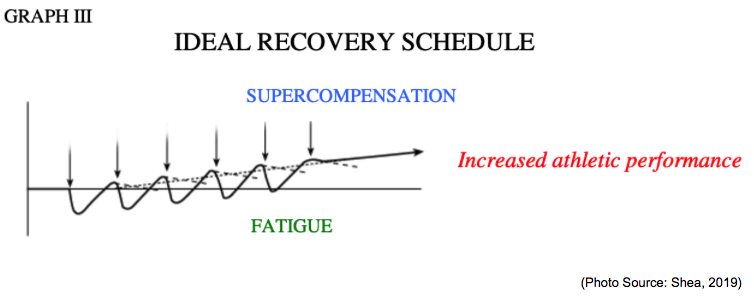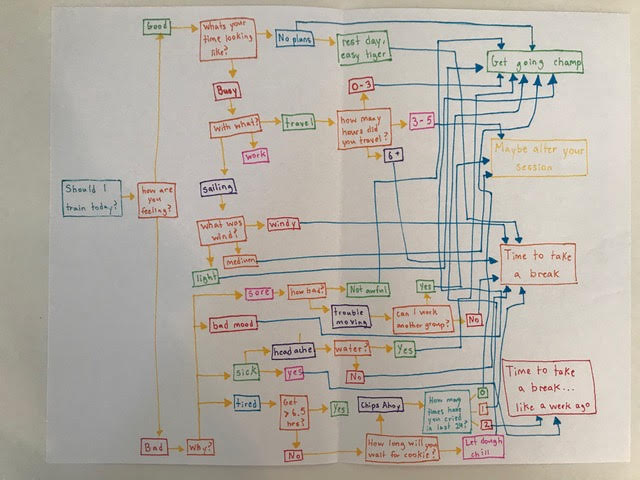
Guide to Understanding the Science Behind Recovery
:By TJ Roney, SPT Coach
“Practice makes perfect” is the saying. Those who practice the most, gain the greatest advantage. Those who train the most, will be the fittest. So, how do we get in more training without harming our bodies by over doing it? We recover. The secret is discovering how to recover quicker, enabling us to get back in the gym, on the water, or the field. In this guide, we explore the science behind the concept in this guide to understanding recovery.
During training sessions, competition, and practice, the body becomes taxed. What is meant by the word taxed is, the breaking down of muscle fiber, as well as fatiguing the body’s energy and central nervous systems. Essentially, the body gets weaker during training. The real gains are seen in recovery. The body’s recovery process is fueled by the food it takes in, and recharged by the duration and quality of sleep it gets, as well as the rest it receives.
As athletes train, their body goes through phases of fatigue, recovery, and supercompensation. The body begins the workout at a baseline, fatigues during the workout, then begins to rebuild itself after the workout during the recovery period. As the body recovers, it repairs itself and hopefully reaches a new “level of physical condition” above the original baseline (Shae, 2019). How long do I need to rest to fully recover? Well, that varies between individual athletes. Figuring out “how hard I can push today, knowing I am going to need to train tomorrow” takes time, attentiveness, and experience. This repetitive cycle of awareness plays a vital role in athletic performance. Paying attention to factors like energy level, resting heart rate, eagerness to train, hunger, and soreness can give insight into whether or not an athlete is ready to get back into the gym, compete, or take a day off.

Think of the body as if it were a battery. Batteries need to be charged. If it is constantly being drained without recharging it fully, it will eventually have no energy left. The key is figuring out how to minimize the time it takes to recharge the battery and then know when it is fully charged. Utilizing assets SPT offers, such as the biometric diary, keeping a training log with notes about each session, or tracking mindset/thinking patterns and nutrition are simple ways to gain self awareness in recovery. The goal is to reach that level of supercompensation – the new baseline, the heightened physical condition – prior to getting back into the gym. This cycle of draining or fatiguing, and recharging to supercompensation will create a wave effect moving towards higher levels of fitness.

Now that we have discussed the science behind training and importance of recovery in relation to athletic performance, let’s dive into how we go about recovering. There are four main factors in addition to resting that will speed up recovery time:
- Nutrition
- Sleep
- Body Work
- Downtime
The first of these is most important, nutrition. Food = Fuel. The body not only needs the correct quantity of calories, but also the proper quality in order to rebuild what has been broken down. Eating clean, quality food will help your body function and rebuild. Without the proper nutrients (micro/macro) recovery will be drastically slowed or unattainable.
Second is sleep, a vital portion of the recovery process. Sleeping is a time for your body to go to work on itself repairing muscle fibers and recharging the central nervous system. However, just closing your eyes does not meet the mark. Quality and quantity are important here as well. Sleep happens in stages, with stage 3 of Non-REM sleep being the goal. Here, “the body repairs and regrows tissues, builds bone and muscle, and strengthens the immune system” while also releasing HGH or Human Growth Hormone into the system to be utilized (Felson, MD, 2018). Ensuring a sufficient duration of uninterrupted sleep is just as important as the quality. Athletes enduring rigorous training to compete at a world class level need a minimum of 9 hours of sleep to properly recover, if not more. The average human or gym goer needs closer to 8 hours, where as anything 7 or less is considered sleep deprived.
Thirdly, bodily maintenance such as professional body work and self myofascial release aides in breaking up adhesions and increasing blood flow to affected areas. Seeking professional help to assist in this process is best. However, using items like lacrosse balls, foam rollers, and electronic muscle stimulation can be done at home and work quite well. Ultimately, these forms of recovery help the body to move freely and efficiently.
Finally, taking time to rest the mind or downtime fulfills the mental side of recovery. The body and mind work together and both need to recover from intense training or competition. Spending time in meditation, taking an epsom salt bath, and walking through the woods are examples of letting the mind to slow down and be free. Taking time to relax the mind allows it recharge the way the body does. Mindset has a profound effect on training. Getting the mind in the right space to train and compete can be exhausting. Allowing time to relax and decompress keeps the mind fresh.
The real take-away from this is to listen to the messages the body sends. Getting in tune to those messages and digging into why they happen, what they mean, and the actions to take in response will ultimately benefit training progress. It is the little things that really matter. Over time, the lack of 30 min or and hour of sleep builds up to days or weeks or months. The can of soda adds up to a 2 liter. Building a solid string of positive choices, actions, and habits will help us reach our goals.
It’s All About Knowing Yourself And Your Goals

SPT Athlete, Hallie Schiffman, shares her visual representation of the thought process she goes through to determine whether or not to train.
For more information about recovery techniques or how SPT’s software can help build your awareness of your body, contact your trainer!


